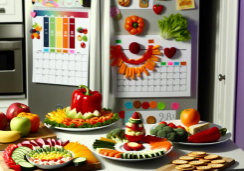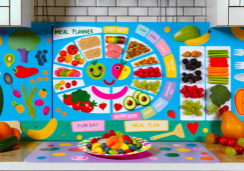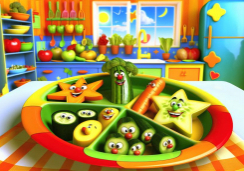7 Tips for a Month-Long Meal Plan for Couples
As the saying goes, 'A couple that plans together, stays together,' and this couldn't be truer when it comes to managing your kitchen. You've likely found that navigating mealtime as a duo can be a dance of preferences, schedules, and budgeting.
To help you choreograph this daily ritual, consider these seven tips for creating a month-long meal plan that resonates with both your taste buds and your time constraints. You'll learn how to assess your dietary preferences and calculate just the right portion sizes to avoid waste.
Moreover, by embracing variety and planning for leftovers strategically, you won't just feed your bodies—you'll nourish your relationship. And when it comes to the nitty-gritty of budgeting and shopping, these tips will transform your grocery runs into a streamlined operation.
So, before you make that impromptu takeout order again, let's explore how a bit of foresight and cooperation can spice up your culinary life together and perhaps save you a surprising amount in the process.
Assess Dietary Preferences
Before embarking on a month-long meal plan, it's essential to sit down together and clearly identify each other's dietary preferences and restrictions, ensuring that every meal is both enjoyable and suitable for both of you. When cooking for one or two people, it's vital to find common ground in your food choices. Be open to incorporating new ingredients or experimenting with recipes that cater to your collective palate.
Pay close attention to any allergies, intolerances, or specific dietary restrictions to ensure meals are safe. This isn't only considerate but also prevents any potential health issues that could arise from incompatible food choices.
An evidence-based, nutrient-focused approach means that you're not just thinking about flavors, but also about the vitamins, minerals, and overall balance your bodies need.
Calculate Portion Sizes
Having assessed dietary preferences, it's crucial now to calculate portion sizes that align with your individual calorie needs and activity levels to maintain a healthy and balanced diet. This step is particularly important when developing meal plans and cooking for one or two people because it helps prevent both overeating and food waste.
To ensure you're eating just the right amount, consider the following:
- Use Measuring Tools: Incorporate measuring cups and scales to portion out meals precisely.
- Divide Recipes Properly: When preparing dishes, divide them into the number of servings recommended in the recipe to avoid the temptation of second helpings.
- Listen to Your Body: Pay attention to hunger cues and adjust portions if you're consistently feeling too full or still hungry after meals.
Remember that portion sizes can vary depending on the type of food and its nutritional content. Lean proteins, whole grains, and vegetables might take up more of your plate than fats and sugars. If you're unsure, consulting a nutritionist or utilizing portion control tools can provide additional guidance.
Embrace Variety and Balance
To keep your shared meals both exciting and nutritious, it's essential to embrace a variety of cuisines and ingredients that contribute to a balanced diet. You don't want to eat the same thing every day; it can lead to boredom and a lack of essential nutrients. Instead, try new recipes that include diverse proteins, from lean meats to plant-based options. Each week, aim to introduce a different protein source to keep things interesting.
Incorporate a colorful array of vegetables to ensure you're getting a spectrum of vitamins and minerals. Don't shy away from experimenting with veggies you haven't tried before—this could lead to discovering new favorites. Carbohydrates are also important for energy, so include whole grains and starchy vegetables in moderation. They'll give you the fuel you need for your daily activities.
Plan for Leftovers Strategically
You've made a delicious dinner, but now you're faced with leftovers. Don't let them go to waste; implement a rotation system to bring them back to the table in new, appealing ways.
Leftover Rotation System
Why not transform last night's roasted chicken into today's savory chicken salad, strategically planning your leftovers to ensure meals stay varied and kitchen time is reduced? A leftover rotation system helps you make the most of each cooking session, especially when cooking for one or two people.
Here's how you can keep it fresh and balanced:
- Repurpose Proteins: Use leftover proteins like chicken or beef in salads, sandwiches, or stir-fries.
- Veggie Variety: Mix leftover veggies into omelets, soups, or as sides for a new main course.
- Carb Control: Refresh carbs like pasta or rice by incorporating them into different cuisines, such as Italian or Asian dishes.
Remember to store leftovers in meal-sized portions, label with dates, and enjoy a nutrient-rich diet with minimal waste.
Creative Reinvention Ideas
While establishing a leftover rotation system streamlines meal planning, embracing creative reinvention ideas will further enhance your culinary experience, turning last night's dinner into today's reimagined feast.
With monthly meal planning, strategic use of leftovers not only minimizes waste but also saves time. Transform leftover proteins and veggies into fresh salads, hearty wraps, or nutritious sandwiches. Merge grains and proteins into soups, stews, and casseroles for a new twist on comfort foods.
To keep your taste buds excited, freeze sauces or broths in ice cube trays—these become convenient flavor boosters for future dishes.
Your goal is a balanced diet, so consider the nutritional value as you repurpose your meals, ensuring each reinvention is as wholesome as it's delicious.
Storing Leftovers Efficiently
To maintain the freshness and quality of your meals, it's essential to store leftovers efficiently, using methods that also align with your nutritional goals and meal planning strategies. When cooking for one or two, you're likely to have extra portions, and storing leftovers efficiently can transform them into time-saving delights for another day.
Here are three key points to ensure you're on the right track:
- Label and Date: Keep track of freshness and organize your fridge with clearly labeled and dated leftovers.
- Airtight Storage: Use containers or Ziploc bags to seal in freshness and prevent contamination.
- Freeze Intentionally: Freeze portions that you won't eat within the next few days for quick meals later on.
Budget Together Smartly
Embarking on a month-long meal plan as a couple requires smart budgeting, ensuring both partners contribute to the financial plan and respect each other's dietary preferences and traditions. You'll want to collaborate on a shared Google doc to discuss and design your master list of meals. This shared space is pivotal for transparency and agreement on your month-long food budget.
As you navigate through this process, be ready to discuss how to split the grocery budget. It's fair to have an open conversation to determine how much each of you believes should be allocated towards food. Remember, food isn't just sustenance; it's steeped in memories, culture, family, and health. Respecting your partner's connection to food is integral to creating a balanced meal plan that satisfies both your nutritional needs and emotional ties.
Transform meal planning into quality time by aligning it with discussions about other weekly plans. This not only strengthens your relationship but also ensures your food budget aligns with your lifestyle and activities. Additionally, inject excitement into your routine by challenging each other to choose a new recipe every month. This practice keeps your meal planning dynamic and ensures a balanced approach to trying new, nutrient-rich dishes while staying within budget.
Schedule Weekly Check-ins
As you plan your meals together, remember to schedule weekly check-ins to ensure you're both satisfied with the meal choices and nutrition balance.
This is the perfect time to adjust meal preferences and align your shopping list with your dietary needs and goals.
Adjusting Meal Preferences
Initiating weekly check-ins provides an invaluable opportunity for couples to fine-tune their meal plan, ensuring it reflects both partners' evolving tastes and nutritional needs. These conversations are essential when you're cooking for one or two because they allow you to adjust your Monthly Meal Plan to suit your shared preferences while maintaining a balanced and nutrient-focused diet.
- Share feedback on the past week's meals and identify favorites
- Explore new recipes or cuisines to keep your meals exciting and diverse
- Address individual dietary needs and find compromises that satisfy both of you
Planning Shopping Together
To streamline your meal planning process, schedule weekly check-ins with your partner to discuss upcoming meals and coordinate grocery shopping lists. These check-ins are pivotal not only to align on preferences and dietary needs but also to prepare meals that are nutritious and satisfying.
Discuss any changes in your schedules or dietary requirements that might affect the week's meals. Take turns leading the conversation to ensure you both have equal say in the food choices and responsibilities.
Use this opportunity to update your shopping list, considering what items are already in your pantry and what's needed for the planned meals. By allocating specific tasks, you'll make grocery shopping more efficient, ensuring you have all the ingredients necessary to prepare balanced and healthful meals throughout the week.
Organize Grocery Shopping Efficiently
Efficient grocery shopping starts with a well-organized list that categorizes items based on the layout of your store, ensuring you don't waste time backtracking for missed ingredients. Before heading out, take inventory of what you already have to prevent buying duplicates, which saves money and reduces food waste. With your month-long meal plan in hand, you'll know exactly what you need, allowing you to focus on nutrient-dense ingredients that contribute to a balanced diet.
When you organize grocery shopping efficiently:
- List by Category: Sort your grocery list into produce, dairy, meats, dry goods, etc., to match the sections of your store.
- Shared Responsibility: Use a shared Google doc to collaborate on the list, making sure both of you can contribute and access it anytime.
- Prevent Waste: Check your pantry, fridge, and freezer to use what you have first, ensuring nothing is overlooked or goes bad.
Consider batch cooking or meal prepping as part of your plan. This approach lets you leverage common ingredients, which simplifies your grocery list and supports a more efficient shopping experience.
Embrace these strategies to make grocery shopping a breeze, allowing you both to enjoy nutritious meals without the stress of daily market runs.
Frequently Asked Questions
How Do I Meal Prep for an Entire Month?
To meal prep for a month, you'll need to focus on ingredient sourcing and recipe rotation. Ensure you're getting a balanced, nutrient-rich diet by planning diverse meals with fresh, seasonal produce.
How Do I Make a One Month Meal Plan?
To make a one-month meal plan, you'll start by budgeting groceries and considering dietary preferences. Focus on nutrient-rich, balanced meals, and don't forget to factor in variety to keep things interesting.
How Do I Meal Prep My Family for a Month?
To meal prep for a month, factor in budget considerations and any dietary restrictions. Ensure your plan is nutrient-focused and balanced, utilizing cost-effective ingredients that cater to your family's health needs.
How Do I Meal Prep With My Partner?
You'll need to coordinate shared kitchen duties and carefully handle recipe selection to create a balanced, nutrient-rich meal prep routine with your partner. It's about teamwork and enjoying the process together.
Conclusion
With your month-long meal plan set, you've taken a big step towards healthier, more efficient eating. Keep in mind each other's dietary needs, portion wisely, and embrace variety.
Smartly using leftovers and budgeting together can stretch your dollar and nourishment. Check in weekly to tweak your plan, ensuring it stays fresh and responsive.
Efficiently organizing your grocery trips saves time and stress. Stick with it, and enjoy the benefits of well-planned, nutritious meals tailored just for the two of you.










